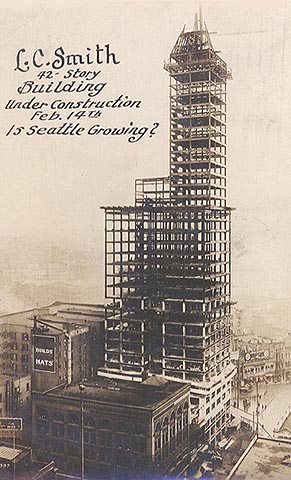

Until the 19th century, buildings of over six stories were rare. The greatest influence was the rise of the industry that led to the rise of the skyscraper. In the American architecture of the time, there was an immense amount of development in both building design and engineering. Left: The Chrysler Building / Right: The Wrigley Building and Tribune Tower in Chicago, 1959, via The Rise of a Skyscraper During the 1920s, he developed his "Mayan style", houses decorated with textured blocks of cement. He identified his architecture as "Usonian", a combination of USA, "utopian" and "organic social order". Meanwhile, in the United States, Frank Lloyd Wright refused to associate himself with any architectural movements considering his work to be entirely unique. Oud, Bart Van der Lack, Cornelis van Eesteren, Jan Wils, and Robert van ‘t Hoff. Some of the most important De Stijl architects were Gerrit Rietveld, J.J.P. Having an awareness of a purified, universal form, De Stijl architecture was seminal for the development of what we today know as Modern architecture. First conceived in 1917 in the Netherlands, De Stijl was introduced as a total style centered around the idea to fathom the purity of form and the reality of nature. Motivated by the liberating spirit of Modernism, it moved away from the ornamentation and introduced simplicity into architecture. Founded by the architect Walter Gropius in Weimar in 1919, Bauhaus ended up as the most influential modernist school for art of the 20th century. Introducing functionalism and purified architectural form to the most radical extremes, it coincided with some of the major artistic movements such as Bauhaus and De Stijl. The 1920s were also marked by the rise of Modernist Architecture that turned the entire context of architectural design upside-down. It became one of the most commonly used architectural style, most notably in the United States after it was first introduced in 1922 during the Chicago Tribune Headquarters design competition. First appearing in France in the 1920s as a combination of art and craftsmanship, the style quickly spread around the globe drawing from the different sources and affecting various disciplines. Often described as a pastiche of styles and an eclectic combination of influences, materials, and shapes, Art Deco was certainly one of the most influential decorative styles in the first half of the twentieth century. Merchandise Mart in Chicago, via Dominant Styles of the 1920s Architecture Styles of this period were eclectic, taking elements of modern design and classical design to form new and interesting facades, breaking from the traditions that dominated the field before World War I. The era saw a boom in the building industry largely in part due to the new ways that materials could be produced. Dominated by a rebellious thought of the influential avant-garde movements, it was an era of innovation in visual art and all creative fields.įollowing this new breath of air, 1920s architecture was dominated by the use of new technologies, building techniques, and construction materials. The roaring ‘20s were a period of great change for America and Western Europe.


 0 kommentar(er)
0 kommentar(er)
